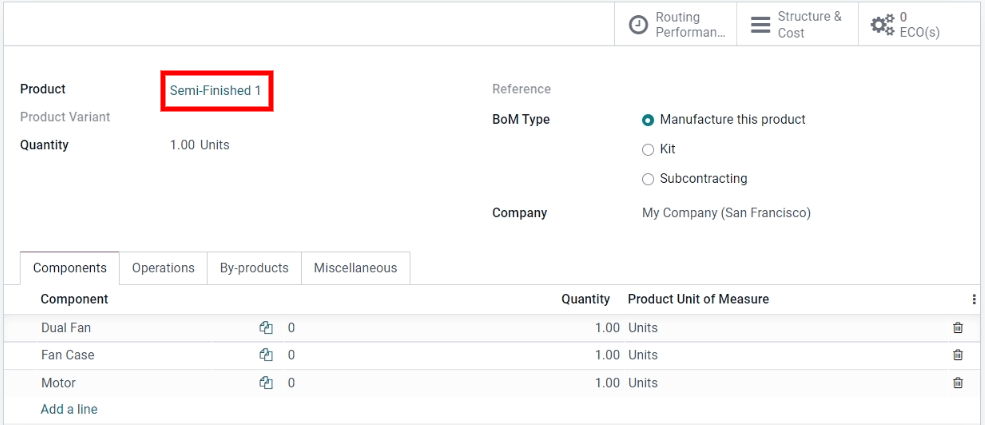Manage semi-finished products¶
A semi-finished product, also known as a subassembly, is a manufactured product that is used as a component in another product’s bill of materials (BoM). Semi-finished products are used to simplify complex BoMs or to more accurately represent a manufacturing flow. A BoM that contains semi-finished products is referred to as a multilevel BoM, where the main top-level product and its subassemblies are distinguished.
Configure semi-finished products¶
To set up a multilevel BoM, the top-level product and semi-finished products must be configured. Therefore, the first step is to create the semi-finished products and their BoMs.
See also

Create the top-level bill of materials (BoM)¶
After the semi-finished products are fully configured, navigate to . Then, Create the top-level product. Configure the product’s specifications as desired, and be sure to Save.
Once the top-level product is configured, click the Bill of Materials smart button on the product form, then click Create to make a BoM for the top-level product. Then, simply add the semi-finished products to this BoM, along with any other necessary components.

Manage production planning¶
There are several methods to manage manufacturing order automation for products with multilevel BoMs.
Note
Semi-finished products are specifically used to manage manufacturable products with multilevel BoMs. If a BoM is being created simply to organize components or bundle sellable products, using Kits is the more appropriate option.
To automatically trigger manufacturing orders for semi-finished products after confirming a manufacturing order for the main product, there are two options:
Option 1 (recommended): Create Reordering Rules for the semi-finished products and set both the minimum and maximum desired stock quantities to
0.
See also
Option 2: Activate the Replenish on Order (MTO) and Manufacture routes under the Inventory tab of the semi-finished product’s product form.
Option 1 is more flexible than Option 2 and is therefore recommended. Reordering rules do not directly link demand to replenishment, and therefore allow stocks to be unreserved and redirected to other orders, if necessary. The Replenish on Order (MTO) route creates a unique link between the semi-finished and top-level products, exclusively reserving quantities for the confirmed top-level manufacturing order.
Regardless of the method chosen, semi-finished products must be fully manufactured before manufacturing can begin on the top-level product.




